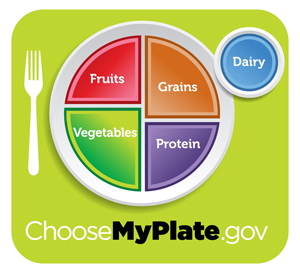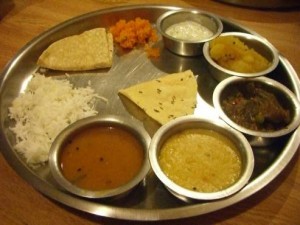On June 2nd, First Lady Michelle Obama , Agriculture Secretary Tom Vilsack and
Surgeon General Regina Benjamin unveiled a new icon to complement the 2010 Dietary Guidelines for Americans . The new symbol for healthy eating called MyPlate will help consumers make better food choices and will replace the food pyramid. 
This means the plate (thali) is in and the MyPyramid is out!
Let’s take a look at the new MyPlate design and compare it with a traditional home-cooked Indian thali. A Thali (Hindi: थाली, meaning “plate”; IPA: [tʰɑːliː] ) refers to an arrangement of food in a round plate (with bowls) or a tray with multiple compartments that has all the food groups in just the right proportions.
The new guidelines recommend filling half the plate with fruits and veggies, 1/4 with grains
and 1/4 with protein. A cup of milk on the side reminds folks to drink low-fat or nonfat milk or
have a cup of yogurt each day.
The new MyPlate is described as-
• colorful
• an easy-to-understand visual cue
• uncomplicated
• simple, actionable advice
A typical traditional home-made Indian thali is nutritionally balanced and a colorful meal. Regardless of regional variances, the thali has the perfect combination of the five food groups, offers variety of textures, and encompasses all the six characteristic tastes – astringent such as beans, cabbage, apple; bitter such as spinach and kale; pungent such as ginger, chili peppers; sweet such as rice, pasta, sugar, cream; sour such as lemon, vinegar, yogurt; and salty, anything to which salt is added. The spices added to food not only add flavor to the meal but research shows that they are a source of antioxidants, phytochemicals and essential oils.
Living in the age of Reality TV, apps, iPhones and Facebook, we have forgotten the importance of having a wholesome and peaceful meals. 
A typical thali is comprised of:
1. Grains – roti or rice, vegetables
2. Protein – beans or lentils
3. Dairy- yogurt/buttermilk/lassi/ ghee
4. Vegetables – cooked and raw (salad)
5. Chutneys. Condiments (aids digestion)
6. Papadam roasted.
7. Desert – carrot halwa/ fruit salad.
Our ancestors on the Indian sub-continent have been using the “Plate Method” for thousands of years to inherently incorporate a daily nutritionally balanced meal without requiring externally enforced guidelines. We have gone a full circle and the MyPlate guidelines that the USDA has launched looks so very promising !
As registered dietitians and bloggers, we’re here to help. Here’s what my RDs colleagues had to say about the new MyPlate:
Janet Helm: Nutrition Unplugged
Bonnie Taub Dix: USA Today
Toby Amidor: Food Network’s Healthy Eats
Elizabeth Ward: Expect the Best
Lisa Young: The Portion Teller
Regan Jones: Professional Palate
Liz Weiss, Janice Bissex: Meal Makeover Moms’ Kitchen
Alysa Bajenaru: Inspired RD
Serena Ball: Teaspoon Communications
Shelley Rael: Eat Well, Live Well, Be Well
Marisa Moore: Marisa Moore Nutrition
Rachel Begun: The Gluten-Free RD
Katie Hamm: Healthy and Happy Hour
Elana Natker: A Sprinkle of Sage
Judy Doherty: Food and Health Communications
Leslie Schilling: Born to Eat
Chere Bork: Taste Life, With Chere
Cathy Leman: NutriFit
Danielle Omar
Marie Spano: Performance Nutrition
Carol Plotkin: On Nutrition
Jessica Levinson: Nutritioulicious
Penny Wilson: Eating for Performance
Heather Mangieri: Nutrition Checkup
Georgia Kostas
Kati Mora: Around the Plate
Emma Stirling: The Scoop on Nutrition
International Food Information Council: Food Insight
